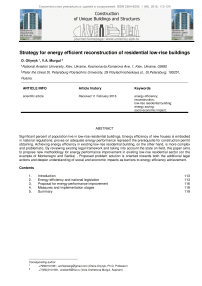Strategy for energy efficient reconstruction of residential low-rise buildings o
Автор: Oliynyk Olena, Murgul Vera Andreevna
Журнал: Строительство уникальных зданий и сооружений @unistroy
Статья в выпуске: 1 (40), 2016 года.
Бесплатный доступ
Significant percent of population live in low-rise residential buildings. Energy efficiency of new houses is embodied in national regulations; proves on adequate energy performance represent the prerequisite for construction permit obtaining. Achieving energy efficiency in existing low-rise residential building, on the other hand, is more complex and problematic. By reviewing existing legal framework and taking into account the state on field, this paper aims to propose new methodology for energy performance improvement in existing low-rise residential sector (on the example of Montenegro and Serbia). Proposed problem solution is oriented towards both the additional legal actions and deeper understanding of social and economic impacts as barriers to energy efficiency achievement.
Energy efficiency, reconstruction, low-rise residential building, energy saving, socio-economic impact
Короткий адрес: https://sciup.org/14322285
IDR: 14322285
Список литературы Strategy for energy efficient reconstruction of residential low-rise buildings o
- Kosanović, S., Arsić, N. A study of energy efficiency within the model for environmental assessment of buildings (2014) GNP 2014, pp. 1617-1624.
- United Nations Economic Commission for Europe: Green Homes -Towards energy efficient housing in the United Nations Economic Commission for Europe Region. United Nations. New York and Geneva (2009)
- Jovanović Popović, M., Kavran, J. Energy efficiency and renewal of residential building stock. Proceedings of the International conference with exhibition S. ARCH -Sustainable architecture (2014) Belgrade, pp. 283-294.
- Amann, W., Kalezić, Đ. State Action plan of Montenegro for energy efficient measures in housing sector (2012) Project report 2012/001. United Nations Economic Commission for Europe (UNECE), Genève, 85 p.
- Kosanović, S. Jovanović Popović, M. Ecological assessment of building materials in Serbia: Constraints and possibilities (2014) International Journal of Contemporary Architecture The New ARCH, Vol. 1 (1), pp. 51-58.
- Information from: http://www.euroace.org/LinkClick.aspx?fileticket=SU86bEBWExk%3d&tabid=69
- Nikčević, R. The Reference book on Energy Efficiency Legal Framework in European Union and in Montenegro. Bar, (2012), 71 p.
- Information from: http://www.energy-community.org/pls/portal/docs/3356393.pdf (10.01.2016)
- Republika Srbija, Ministarstvo životne sredine, rudarstva i prostornog planiranja: Pravilnik o energetskoj efikasnosti zgrada (Rulebook on energy efficiency of buildings). "Službeni glasnik RS", br. 61/2011 (2011)
- Republika Srbija, Ministarstvo životne sredine, rudarstva i prostornog planiranja: Pravilnik o uslovima, sadržini i načinu izdavanja sertifikata o energetskim svojstvima zgrada(Rulebook on terms, content and ways of issuing the certificates of energy performance of buildings). "Službeni glasnik RS", br. 61/2011 (2011)
- Crna Gora, Ministarstvo ekonomije uz saglasnost Ministarstva održivog razvoja i turizma: Pravilnik o minimalnim zahtjevima energetske efikasnosti zgrada (Rulebook on minimal requirements for energy efficiency of buildings). "Službeni list Crne Gore", br. 23/13 (2013)
- Crna Gora, Ministarstvo ekonomije: Pravilnik o sertifikovanju energetskih karakteristika zgrada (Rulebook on certification of energy performance of buildings)."Službeni list Crne Gore", br. 24/2013 (2013)
- Crna Gora, Ministarstvo ekonomije: Pravilnik o programu obuke za energetske preglede, sadržaju zahtjeva za izdavanje ovlašćenja i registra ovlašćenih lica (Rulebook on the training for energy audits, content of the application for authorization issuing and the register of authorized persons). "Službeni list Crne Gore", br. 24/2013 (2013)
- Jovanović Popović, M., Ignjatović, D. eds. National typology of residential buildings in Serbia. (2014) Faculty of Architecture of University of Belgrade and GIZ -Deutsche Gesellschaft für Internationale Zusammenarbeit, 253 p.
- Deda, P. Georgiadis, G. Tackling climate change -trends and challenges in enhancing energy efficiency in building in the ECE region (2009) ECE Annual Report 2009. ECE, Geneva, 132 p.
- Information from http://energytransition.de/(09/02/2016)
- Kosanović S., Komatina, D., Nikčević, R., Murgul, V., Vatin, N. Energy Efficiency of Single-family Houses in Serbia and Montenegro: Strategy for Upgrading the Performance of Existing Stock, Applied Mechanics and Materials, Vols. 725-726 (2015) pp 1486-1492
- Ćetković J., Rutešić S., Zarković M., Knežević M., Vatin N. Primary directions and advancements in competitiveness of montenegrin construction sector (2015) Procedia Engineering, 117 (1), pp. 780-790
- Harmati N., Jakšić Z., Vatin N. Energy consumption modelling via heat balance method for energy performance of a building (2015) Procedia Engineering, 117 (1), pp. 791-799.
- Rutešić S., Ćetković J., Žarcković M., Knežević M., Vatin N. Analysis of the situation in montenegrin civil engineering sector from the point of application of national regulations and the EU technical standards in construction (2015) Procedia Engineering, 117 (1), pp. 905-915.
- Tanic M., Stankovic D., Nikolic V., Nikolic M., Kostic D., Milojkovic A., Spasic S., Vatin N. Reducing energy consumption by optimizing thermal losses and measures of energy recovery in preschools (2015) Procedia Engineering, 117 (1), pp. 924-937.
- Melović B., Mitrović S., Djokaj A., Vatin N. Logistics in the function of customer service-Relevance for the engineering management (2015) Procedia Engineering, 117 (1), pp. 807-812.
- Rutešić S., Ćetković J., Knežević M., Žarcković M., Vatin N. Institutional framework, current investments and future strategic direction for development of construction sector in Montenegro (2015) Procedia Engineering, 117 (1), pp. 642-650.
- Ognjenovic S., Donceva R., Vatin N. Dynamic homogeneity and functional dependence on the number of traffic accidents, the role in urban planning (2015) Procedia Engineering, 117 (1), pp. 556-563.
- Stamatovic B., Upadhyay R., Vatin N. Cellular automata in modeling of porous building materials and solis porous media (2015) Procedia Engineering, 117 (1), pp. 660-667.


